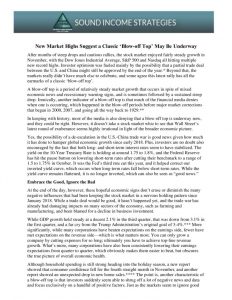December 2019
| Index | YTD | Month |
| DOW | +25.07% | + 1.86% |
| S&P500 | +31.19% | + 3.00% |
| NASDAQ | +36.55% | + 3.64% |
| Barclays | +8.71% | – 0.60% |
10-Yr Treasury yield was 1.77% at the end of November and 1.91% at the end of December. It began the year at 2.68%, giving us a TR of +8.8% for 2019.
Market
The stock market’s blow-off top rally, which began in late October, continued in December, with all the major market indexes hitting new record highs. That great finish looked even better considering 2018 marked Wall Street’s worst year in a decade. Initially, the rally continued into 2020 before Wall Street started tapping the breaks in response to new mounting tensions in the Middle East.*
Overall, 2019 was a strong year for the stock market, with the Dow Jones Industrial Average finishing up 22.3%, the S&P 500 up 28.9%, and the Nasdaq up 35.2%.** All this occurred despite the fact that corporate earnings were flat,*** while long-term interest rates stabilized late in the year at between 1.5 and 2%.**** Then, on the first day of trading in 2020, the Dow added another 1.2%, the S&P 500 climbed another 0.8%, and the Nasdaq ended 1.3% higher.*****
What prompted all the New Year’s optimism? It was attributed mainly to an announcement by China’s central bank that it was launching a new artificial stimulus effort. Following the announcement, China’s main market indexes each jumped by 1.2%. That optimism quickly spilled over into the US and European markets, demonstrating again how the modern global economy is more interconnected than ever—and how markets everywhere have become addicted to artificial stimulus.
With our own Federal Reserve also engaged in more quantitative easing,****** I’m forecasting that the current blow-off top rally could continue in 2020—and possibly into 2021 since it is an election year. With the Fed again buying up short-term treasuries, they’re clearly trying to ignore the logical message from the bond market that the economy is slowing, and to feed Wall Street’s irrational exuberance with more artificial tinkering. With that in mind, it’s possible this blow-off top may add another 10 to 20% market growth this year before reality hits. In the meantime, though, I believe that overall low interest rates will remain the norm, and GDP growth will remain stagnant or continue to decline slightly in the year ahead.
Ultimately, the two important questions for investors to keep in mind as they track the blow-off stock market in the coming year are: “Is it real, and if not, do I really want to bet on something that’s artificial?”
Portfolio Transactions:
When managing your portfolio at SIS, we look for one of four possible “enhancement” trades while reviewing securities and possible transactions. Income generation is our primary goal for our clients, and we consider the following four portfolio enhancements before transacting: current yield, yield to worst (minimum projected annualized total return), interest rate risk, and default risk. The intents of these transactions are categorized as follows:
- Pay Me Now – Enhancing current yield
- Pay Me Later – Enhancing yield to worst
- Cover My Assets I. – Managing interest rate risk
- Cover My Assets II. – Managing default risk
While GDP growth held steady at a decent 2.1% in the third quarter, that was down from 3.1% in the first quarter, and a far cry from the Trump Administration’s original goal of 3-4%.*** More significantly, while many corporations have beaten expectations on the earnings side, fewer have met expectations on the revenue side—which is what matters most. You can only grow a company by cutting expenses for so long; ultimately you have to achieve top-line revenue growth. What’s more, many corporations have also been consistently lowering their earnings expectations from quarter to quarter, which obviously makes them easier to beat, but obscures the true picture of overall economic health.
We evaluate the transactions by determining whether they meet one, two, three, or all four enhancements. A baseball analogy for this: SINGLES, DOUBLES, TRIPLES, and HOME RUNS.
There were no swaps in December.
Best,
Dave
* “Dow Slides 130 Points, Oil Prices Jump As Iran Tensions Escalate,” USA Today, Jan. 6, 2020
**“Stock Market Ends 2019 On a High Note,” MarketWatch, Dec. 31, 2019
***“The Downside of a Stellar 2019,” Fortune, Jan. 7, 2020
****MacroTrends.net
*****“The Dow Kicks Off the New Year With a Record High,” CNN Business, Jan. 2, 2020
******“Fed Will Purchase Treasury Bills at Least into 2Q of 2020,” Wall Street Journal, Oct. 11, 2019
More Troubling Signs
In addition to the middling economic picture and indicators of slowing growth, there are other troubling signs that investors appear to be shrugging off. As I’ve pointed out in previous newsletters, the International Monetary Fund has warned that the global economy is in a synchronized slowdown and likely headed toward recession.***** Additionally, despite the Fed’s denial, we are once again in a period of quantitative easing thanks to a troubling banking crisis that occurred back in September. As I explained at the time, the overnight repo market experienced a liquidity crunch that forced the Fed to quickly pump billions of dollars into the banking system—but even that wasn’t enough.
In their ongoing effort to address the problem, the Fed began buying up short-term Treasury bills last month at $60 billion per month and will continue doing so into the second quarter of next year.****** While Fed Chairman Jerome Powell has said flatly, “In no sense is this QE,” he’s wrong. More quantitative easing is exactly what it is—and further evidence that the economy isn’t really strong or stable enough to justify Wall Street’s sudden exuberance. Even more troubling is the fact that some see parallels between the recent repo market mystery and the subprime mortgage mess that led to the Financial Crisis ten years ago.
Ultimately, a blow-off top represents a good example of why the bond market is often said to be smarter than the stock market. How so? With the yield on the 10-Year Treasury holding at around 1.75 to 1.8%, that certainly doesn’t reflect the kind of economic growth we’d need to justify a booming stock market. The two markets are in disagreement because the bond market is guided by logic while the stock market is driven by emotion and animal spirits. How long might the blow-off last? Could the Dow make it all the way to 35,000 before the bottom falls out? No one knows, of course, but I submit that everyday investors—especially those in or nearing retirement—would be wise to take their lead from the bond market in this situation. While it’s easy to get caught up in the hype and emotion of a soaring stock market, consider the broader picture first and ask yourself: is it logical?
*“U.S. Stocks End at All-Time Highs,” MarketWatch, Nov. 26, 2019
**“Why Dow 28,000 Could Mark That Blow-Off Top Bears Have Been Predicting,” MarketWatch, Nov. 23
***countryeconomy.com
****“U.S. Consumer Confidence Ebbing,” Reuters, Nov. 26, 2019
*****“Fed Will Purchase Treasury Bills at Least into 2Q of 2020,” Wall Street Journal, Oct. 11, 2019
******“The World Economy: Synchronized Slowdown, Precarious Outlook,” IMFblog.com, Oct. 15, 2019
Note: The above trades were recent block trades and do not reflect all trades done on an individual specific basis. Sound Income Strategies, LLC is a registered investment advisor. Information presented is for educational purposes only and does not intend to make an offer or solicitation for the sale or purchase of any specific securities, investments, or investment strategies. Investments involve risk and, unless otherwise stated, are not guaranteed. Past performance is not an indication of future results. Be sure to first consult with a qualified financial advisor or tax professional about your specific financial situation before implementing any strategy discussed herein.
You are advised to give independent consideration to, and conduct independent investigation with regards to the information above in accordance with your individual investment objectives. Use of the Information is at the reader’s risk, is strictly intended for informational purposes in conjunction with the recipient’s due diligence, and should not be construed as a solicitation by Sound Income Strategies, LLC. Past performance will never indicate or guarantee future behavior. Sound Income Strategies, LLC does not represent or warrant that the contents of the document are suitable for you from compliance, regulatory, legal, or any other perspective. We shall have no responsibility or liability for your use or non-use of the document or any portion thereof.
Sound Income Strategies, LLC is registered as an investment advisor under the Investment Advisers Act of 1940 and is regulated by the SEC. Sound Income Strategies, LLC and its affiliates may only transact business or render personalized investment advice in those states and jurisdictions where we are registered or otherwise qualified to do so. Investment Advisory Services offered through Sound Income Strategies, LLC, an SEC Registered Investment Advisory Firm.
**For Advisor Use Only*
Our Team

David Scranton, CEO
dscranton@3.140.45.217
Ext. 125

Steve Cox, COO
scox@3.140.45.217
Ext. 107

Eric Lutton, CIO
elutton@3.140.45.217
Ext. 146

Charles Radlauer, CCO
cradlauer@3.140.45.217
Ext. 150

Rick Bates, VP of Business Development
rbates@3.140.45.217
Ext. 189

Steven Szikszay, Junior Financial Analyst
sszikszay@3.140.45.217
Ext. 140

Delsy Kasmaii, Junior Financial Analyst
dkasmaii@3.140.45.217
Ext. 154

Keely Escalante, Operations Specialist
kescalante@3.140.45.217
Ext. 138

